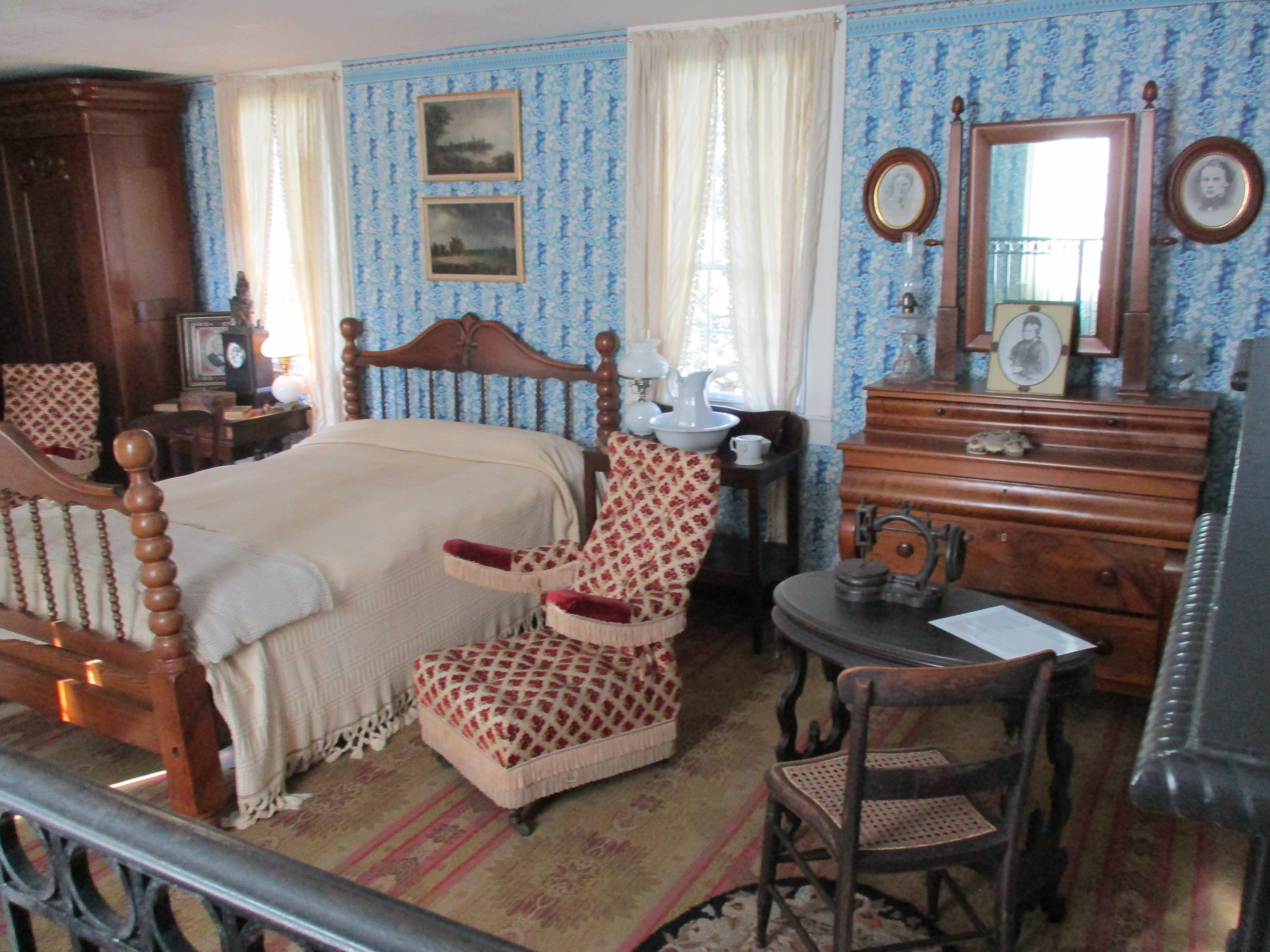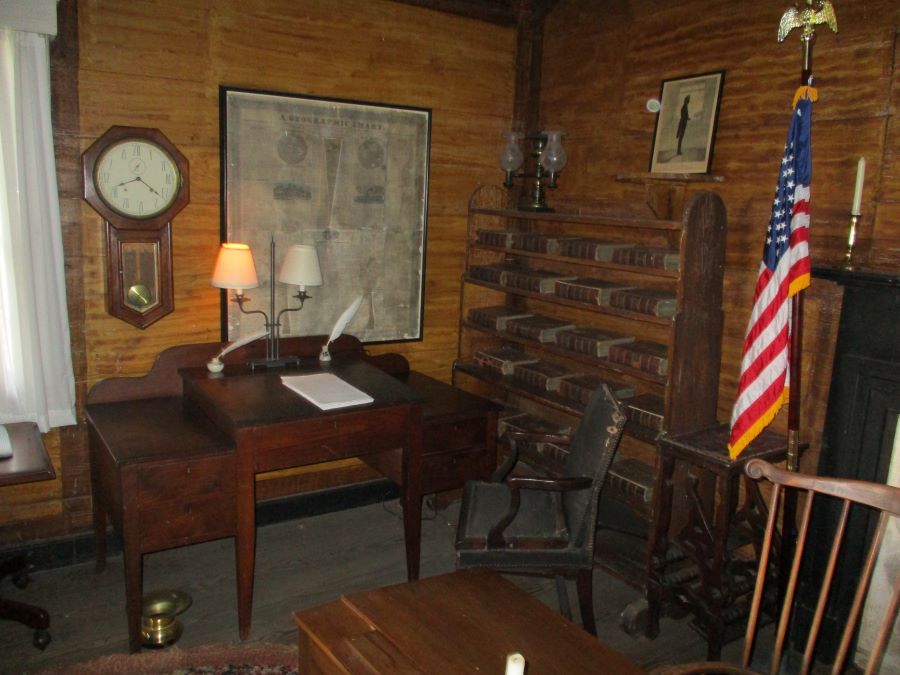|
There are lots of old
plantations and plantation houses scattered
across the South. Many are special, usually due
to some sort of historical connection. Fort Hill
was the antebellum plantation of John C.
Calhoun, a preeminent nineteenth century
southern statesman and later the home of Thomas
G. Clemson, his son-in-law. It is unusual for a
number of reasons: it is furnished as an
historic house museum, primarily with original
furnishing from the Calhoun family and Clemson
family; due to the historical legacy of both
families, it is full of fascinating historical
artifacts; and it is a historical site hidden in
plain sight, in the center of a major university
campus.
Fort Hill (named after
nearby Fort Rutledge, built in 1776 as part of a
campaign against the Cherokee Nation) is a white
columned “Big House,” typical of a southern
plantation. It sits on a small hill in the
middle of about five acres (the remains of an
1,100-acre plantation). It was John C. Calhoun’s
home from 1825 until 1850. While located in the
center of Clemson University’s campus, it is
screened from most of the campus development by
large trees and shrubs, many planted by Calhoun
himself.
John C. Calhoun and Thomas G. Clemson
First, a brief overview
of the history. John C. Calhoun was elected to
the House of Representatives in 1810. He was a
leading supporter of the War of 1812 against
Great Britain and served as Secretary of War
under President James Monroe. In 1824 he was a
candidate for President, but ended up serving as
Vice President under John Quincey Adams, and
then as Vice President under Andrew Jackson
after the 1828 election. From 1832 to his death
in 1850 he served as a United States Senator
from South Carolina, interrupted from 1844-1845
when he served as Secretary of State under
President John Tyler. Calhoun was one of the
“Great Triumvirate” of the United States
Congress during the early nineteenth century,
along with Henry Clay and Daniel Webster. He was
a champion of state’s rights and slavery and a
symbol of the “Old South.” He is often credited
with sowing seeds that led to the American Civil
War.
Thomas G. Clemson
married John C. Calhoun’s oldest daughter, Anna
Marie. Clemson was educated and had a major
interest in agriculture. From 1860 to 1861 he
served as Superintendent of Agriculture under
President Buchanan, leaving that position at the
start of the Civil War. Clemson ended up owning
Fort Hill and deeded it to the State of South
Carolina on the condition it be used to
establish a land-grant college devoted to the
sciences and agriculture (The Clemson
Agricultural College of South Carolina, today’s
Clemson University). Today the mansion and
grounds are well-maintained and open to the
public.
Fort Hill Today
Fort Hill sits in the
center of the Clemson University campus on a
hilltop, almost hidden by large trees and
shrubs. It is very close to the football stadium
and it is likely many fans have no idea it is
nearby. The library and office are adjacent to
the mansion and a few other features, like the
Spring House are also nearby.
 |
| The
plantation house or “the big house” sit
on top of a hill, almost hidden by
vegetation. |
 |
| The spring
house is still there for visitors to
see. |
The first floor includes
a reconstructed plantation kitchen, state dining
room, parlor, and, master bedroom. The kitchen
is separated from the main house by a few feet.
The entrance hall contains a portrait of John C.
Calhoun, a matching pair of Empire pier tables,
and a marble-top table. In the state dining room
Mrs. Calhoun’s wedding portrait is over the
mantle. The banquet table and chairs were
designed by Duncan Phyfe about 1820. The dining
room also contains the U.S.S. Constitution
sideboard made from mahogany from the famous
frigate “Old Ironsides” (a gift to Secretary of
War Calhoun from Senator Henry Clay). The master
bedroom features a massive Empire bed and
Piedmont wardrobe by William Knauff. In the
parlor is Calhoun’s prized Windsor chair which
once belonged to George Washington.
 |
| The State
Dining Room. |
 |
| The Parlor. |
The second floor is mainly bedroom and dressing
rooms. The master bedroom was downstairs. These
rooms were mainly used by the children.
 |
| One of the
second story bedrooms. |
 |
| One of
the second story bedrooms. |
Calhoun’s one-room library or plantation office
is located about 50 feet south of the mansion.
It is probably the most interesting room
associated with the mansion, as it is where John
C. Calhoun did much of his writing and thinking.
The National Register of Historic Places
Nomination Form has a description of the office:
“The library has its sides filled with
bookshelves, and these are packed with volumes
of every description, though largely the
literature of law and rostrum. Calhoun’s own
speeches appear in several editions, and there
are many books that bear the marks of his pen.”
For safekeeping the books were stored in the
College Library, resulting in their loss in an
1894 fire. Today it houses an interesting
collection of early maps and many Calhoun
furnishings, including his chair from the U.S,
Senate and a carved roll-top desk which he used
while Vice-President. The library was built
about 1825 and has a columned porch in front and
a fireplace on the south side. The interior is
oak-paneled and has a high ceiling. Under the
building is a walled excavation that served as
an icehouse.
While Calhoun spent much of his last twenty-five
years in Washington, D.C., he returned whenever
he had the opportunity and wrote some of his
most important speeches and papers there, most
likely in the library. During the Congressional
recess of 1828 he returned to South Carolina to
write his “South Carolina Exposition,” that is
the foundation of the doctrine of nullification
(state’s may nullify federal law). During his
last summer at Fort Hill he wrote his famous
“Discourse on the Constitution of the United
States” and essay “A Disquisition on
Government.” These gave his views on state
sovereignty, the concurrent majority, and the
nature of the union. He is noted as being one of
the strongest proponents of the Southern
viewpoint during the Great Compromise of 1850
dealing with westward expansion of slavery.
 |
| The plantation
library and office is actually a
separate building. |
 |
The plantation
desk was used by Calhoun to write the
“Fort Hill Address” in 1831.
Then Vice President Calhoun expressed
support for nullification and state’s
rights.
President Jackson strongly opposed those
views and Calhoun resigned the following
year. |
 |
| The maps
in the room belonged to Calhoun and were
used by him. |
 |
| This was desk
used by Calhoun in the U.S, House of
Representatives. |
 |
| Desk given to
Calhoun by the people of South Carolina
while he was Vice President. |
Fort Hill represents a wonderful opportunity to
visit a real southern plantation mansion
furnished with mostly original historical
furniture and artifacts. It is also a chance to
learn southern history and even the history of
Clemson University. The library has to be the
most interesting part of Fort Hill. The original
desk, chairs, and maps are absolutely
fascinating. It is only ten miles from
Interstate 85, about half-way between Atlanta
and Charlotte, and it is well worth a stop.
Author: Thomas J. Straka is a forestry professor
at Clemson University. He has a keen interest in
history.
|








